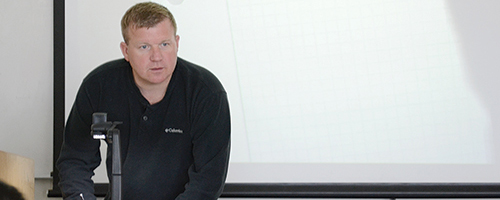Oregonian columnist David Sarasohn recently quoted PSU President Wim Wiewel as saying that what is in store for the university next year is “… quite scary, actually …” regarding the very real possibility that there will be less funding for the university, with more students enrolling all the time, and a near certainty that there will be a substantial increase in tuition.
Service and repair
Oregonian columnist David Sarasohn recently quoted PSU President Wim Wiewel as saying that what is in store for the university next year is “… quite scary, actually …” regarding the very real possibility that there will be less funding for the university, with more students enrolling all the time, and a near certainty that there will be a substantial increase in tuition.
Let me get this straight: More people will be competing for fewer resources and paying more for it? Yep, that’s about the size of it. Our university’s president is right, that certainly is pretty scary.
Although Wiewel seems to be an excellent match for PSU in terms of his commitment to sustainability and cooperation with the community, I can’t help thinking about some of the other points he stressed that, as PSU’s new president, he would be devoting some significant effort to, for example: increase plus continue access to higher education, keep tuition costs low, obtain more money through endowments and grants then let the staff use it to provide education to those who seek it.
OK, now would be a terrific time to make good on these claims.
Many students are just breaking even financially while they are pursuing degrees, a great many more are plummeting heavily into debt in the process. I know that a pretty significant reason (for me) for choosing PSU was the low tuition cost.
Wiewel suggests that in order to compensate for budget cuts, the university looks forward to tuition increases of 15 percent each year for the next two years. I’m not too crazy about this idea. I refer back to President Wiewel’s goal of actively seek ways to provide more resources and a better education to more students without jacking up the cost. From what I can tell, it seems like the exact opposite is happening.
If more students are being admitted to PSU, and they’re paying tuition, then why is that money not a factor in the university’s potential to hire more instructors, and offer more classes? If we were talking about a business for profit, that’s about exactly how it should play out. More customers would mean more money, some of which would go to expand/improve the business.
If Portland State were a commercial enterprise that I patronized, I’d be seriously considering taking my trade elsewhere at this point, just to avoid feeling like a total sucker. What other kinds of business, when confronted by an expanding customer base, would reward their patrons by raising prices, cutting hours and offering an inferior service or product? Even if it were just a small increase, even if I wasn’t seriously inconvenient—I’d still consider a boycott, as a matter of principle.
Not only are students facing hard economic times, everyone is, in some way, with more to come. Everyone has to sacrifice; everyone will feel the crunch.
Students are being told by the university’s president that they are in for some “pretty scary” times ahead—mind you, this is coming from a man who was hired at a starting salary of $350,000 a year, whose wife was given a position at PSU created specially for her (to sweeten the offer to make the move to Oregon) and whose housing is quite handsomely provided for by the university system. I don’t bring this up to begrudge the Wiewels any of their professional or personal successes. I mention it because I think the PSU president and I might have very different measuring stick of what “scary” is.
PSU students are attending a school that proudly claims to be the largest public university in Oregon, yet the influx of new admissions is threatening to strain resources beyond endurance. Puzzlingly, these new students bring with them the very resource the school is apparently the most in need of—more money (in the form of tuition). Yet it seems that more is less in this case—the more students there are, the less of a chance we have of getting a quality education.
We go to a university that prides itself on embracing diversity, yet in February of this year, the school paid $795,000 in a racial discrimination lawsuit to former vice provost Douglas Samuels. (That would pay a year’s tuition for more than 130 students or pay the salary of about 15 full-time professors.)
We go to PSU to get an education; in most cases that means earning a degree. Portland State has an abysmal graduation rate—only 14.5 percent of undergraduate students earn their bachelor’s degree in four years. Slightly over 37 percent manage to earn that degree in six years.
In any other circumstance, only the most thrill-seeking gamblers would accept these limitations and these odds. The only things students are being promised are that there’s a really good chance they will fail to accomplish their goal of getting a degree, that things are very likely in the process of getting worse and for the students that are coming up behind them—even worse yet.
That’s what’s scary to me. Something’s broken. Can anybody fix it?



